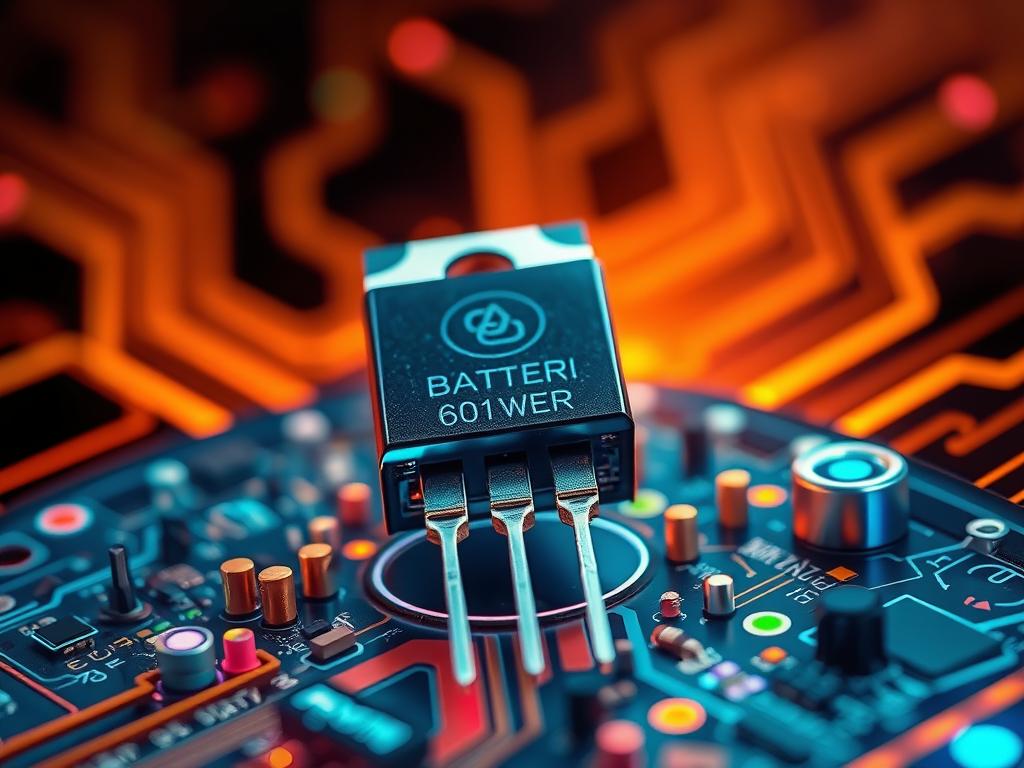Battery monitoring is key for keeping modern battery systems safe and efficient. Industries use battery management systems (BMS) to watch over and improve battery performance. Transistors, with their great voltage and current control, are vital for BMS. They help lithium-ion rechargeable cells keep their high energy density.
The need for dependable battery monitoring is growing in many fields, like cars and green energy. Designing BMS has to consider cost, complexity, safety, lifespan, and meeting rules. Transistors help make these systems better, ensuring batteries work well and last longer.
As battery tech and monitoring systems get better, safety and efficiency become more important. It’s important for engineers and tech pros to understand how transistors and battery monitoring work together. This helps them improve battery performance.
Key Takeaways
- Battery monitoring is essential for maintaining safety and efficiency in battery systems.
- Transistors play a pivotal role in enhancing battery management system functionalities.
- Challenges in BMS design include cost and regulatory compliance.
- Effective battery management ensures optimized performance and longevity.
- Lithium-ion cells require careful monitoring of current and voltage limits.
- Real-time data and alerts are critical for preventing battery operations outside safe margins.
Introduction to Battery Monitoring Technologies
Battery monitoring technologies are key to keeping battery systems running well. They watch over things like voltage, current, and temperature. This helps keep batteries in top shape. Battery Management Systems (BMS) make these checks possible, boosting both efficiency and safety.
Overview of Battery Monitoring Systems
Battery Monitoring Systems manage and check battery performance in many areas. They have parts that do things like balance cells, stop overcharging, and watch temperature. Companies like Texas Instruments and Analog Devices lead in making these systems better. A BMS’s main features include:
- Voltage range
- Current rating
- Temperature range
- Accuracy of measurements
Importance of Safety and Efficiency
Safety is always first when it comes to battery management. Good battery monitoring cuts down on risks like overheating and fires. It keeps batteries working well and safe, making them last longer and perform better.
Role of Transistors in Battery Monitoring
Transistors are crucial in Battery Management Systems. They help control important processes and improve communication. By controlling voltage and current well, transistors make battery monitoring more efficient and safe.
What Are Transistors?
Transistors are key to modern electronics. They do more than just amplify signals. They play a big role in many devices. Knowing what transistors are is crucial for those in the electronics field.
These semiconductor devices act as amplifiers and switches. They control electric currents and voltages. This is important for things like battery monitoring systems.
Definition and Functionality of Transistors
Transistors are solid-state devices that control current flow. They can switch on and off, which is vital for digital circuits. This switching helps computers, cars, and other devices process data.
Types of Transistors Used in Battery Systems
There are different types of transistors, like MOSFETs and BJTs, used in battery systems. MOSFETs are popular because they switch fast and handle a lot of current. The right transistor is chosen for each application, like electric cars or portable gadgets.
Advantages of Using Transistors
Using transistors in battery systems has big benefits. They make energy use more efficient and reduce heat. Transistors are reliable in high-power uses, making them key in advanced battery systems.
They are small and use little power. This makes them valuable in today’s electronics.

The Importance of Safety in Battery Monitoring
Battery safety is key in today’s battery management systems. Knowing the risks helps avoid dangers and keeps systems running smoothly. Battery monitoring systems are vital in managing these risks, especially with lithium-ion batteries.
Risks Associated with Battery Failure
Battery failure can cause big problems. Issues like thermal runaway, cell degradation, and catastrophic failures are serious. These can lead to performance drops, explosions, or fires. Without careful monitoring, these risks grow, making safety a top concern.
How Transistors Enhance Safety
Transistors are crucial for keeping battery systems safe. They control charging and discharging, preventing failures. Using advanced transistors in BMSs helps manage heat and prevent short circuits. This reduces safety risks in battery use. For more on smart power transistors in battery systems, see this article.
Regulatory Standards and Compliance
Following regulatory standards is vital for battery safety. Rules from groups like UL and IEC ensure systems meet safety levels. A good BMS keeps systems safe and working well, making standards key in battery tech.
Enhancing Efficiency with Transistors
Transistors are key to making battery systems more efficient. They help control power flow, reducing energy loss. Modern transistors, especially those made from gallium nitride (GaN), have a big transistor impact on system performance.
Mechanisms of Efficiency Improvement
GaN transistors have lower resistance, making power conversion more effective. They can work at higher frequencies, leading to better switching and efficiency. This helps keep batteries performing well and saves energy.
Impact on Battery Lifespan
Advanced transistors help batteries last longer by managing power better. They prevent overcharging, which is good for battery lifespan. New research aims to make batteries work even better, extending their life.
Potential Cost Savings
Efficiency gains mean cost savings for everyone. Using GaN transistors can cut down on battery replacements and energy costs. It’s estimated that these new transistors could save 10 percent to 20 percent of U.S. electricity. For more on efficient switching regulators, check out this resource.

| Transistor Type | Resistance Level | Breakdown Voltage | Electron Movement Speed |
|---|---|---|---|
| Gallium Nitride (GaN) | 100 to 1,000 times lower | 10 times higher | 10 times faster |
| Silicon Carbide (SiC) | Moderate | Higher than Si | Moderate |
| Silicon (Si) | Standard | Lower than GaN | Lower compared to GaN |
Key Features of Battery Monitoring Systems
Battery Monitoring Systems (BMS) are key for efficient and safe battery use. They use advanced features to ensure top performance and safety. These systems help extend battery life and improve user experience.
Real-Time Data Tracking
Real-Time Tracking is a key feature of BMS. It continuously checks important factors like voltage, current, and temperature. This helps keep each cell safe and working right, preventing damage and extending battery life.
Alerts and Notifications
Alerts are a vital part of BMS features. They send out warnings for issues like over-voltage, low temperature, or short circuits. These alerts help users act fast to avoid battery failure or danger, making battery systems safer.
Integration with Smart Technologies
Smart Technologies integration makes BMS work better with other devices. It allows for smart decisions based on battery state. With data analytics and machine learning, BMS can improve battery performance and offer insights for better management. This leads to better energy use and longer battery life.
Transistor-Based Sensor Technologies
Transistor-based sensors are key in today’s battery monitoring systems. They collect important data on voltage, current, and temperature. This ensures batteries work well and safely. Different sensors have special features that boost the system’s performance.
Types of Sensors in Battery Monitoring
- Current Sensors: Measure the flow of current, helping to maintain optimal battery operation.
- Temperature Sensors: Monitor thermal levels to prevent overheating and ensure safety.
- Voltage Dividers: Help manage and assess voltage levels within the system, ensuring accuracy in measurements.
Benefits of Transistor-Based Sensors
Transistor-based sensors bring many benefits to battery monitoring. They are very sensitive, catching small changes. They also use little power, making them great for constant use. Their quick response times give real-time data, which is vital for quick actions.
Case Studies of Successful Implementations
Transistor-based sensors have shown success in many areas. In electric vehicles, they improve battery monitoring. This leads to better performance in various conditions. For more on related tech, check out this resource on wearable biosensors.

Designing an Effective Battery Monitoring System
Creating a good battery monitoring system needs a deep understanding of its key components. These include sensors, control circuits, and transistors. Each part is crucial for better efficiency and safety. Transistors help in precise battery performance monitoring and management.
Key Components of the Design
The main parts needed for a top-notch Battery Monitoring System Design are:
- Sensors: To measure voltage, current, and temperature.
- Microcontrollers: For processing data, ensuring system functionalities.
- Transistors: For switching and signal amplification tasks.
- Circuit Protection Devices: To safeguard against overload and short circuits.
Selecting the Right Transistors
Picking the right transistors is key in the monitoring system. They must handle the maximum load efficiently. It’s important to think about heat dissipation, switching speed, and voltage ratings. Advances in transistor technology have made them more reliable and efficient in battery systems.
Common Design Challenges
Even with progress in Battery Monitoring System Design, some challenges still exist:
- Thermal Management: Keeping the system cool to avoid overheating.
- Minimizing Power Consumption: Making sure the system uses as little power as possible for better efficiency.
- Reliability: Creating systems that work well in different conditions without breaking down.
Overcoming these challenges is vital for the best performance. Knowing how to integrate components and their roles leads to a better design. This improves the safety and efficiency of battery monitoring systems.
Communication Protocols in Battery Monitoring
Effective communication protocols are key in battery monitoring systems. They ensure data flows smoothly between parts and outside interfaces. Standards like CAN, UART, and I2C are crucial for reliable data exchange, boosting system performance.
Overview of Communication Standards
Battery Management Systems (BMS) use various communication protocols. These protocols keep data safe and improve system safety and efficiency. They also help components like voltage and temperature monitors work together smoothly.
Role of Transistors in Data Transmission
Transistors are essential in battery management systems for data transmission. They act as electronic switches, allowing information to flow and signals to be amplified. This makes data transmission more reliable, ensuring accurate and timely battery metrics.
For example, the Battery Management Unit (BMU) tracks voltage and current. It uses transistors to prevent overcharging or deep discharging, keeping batteries safe.
Future Trends in Communication Technologies
Communication technologies in battery monitoring are evolving. There’s a move towards more integrated protocols that improve connectivity and data exchange. This could lead to better real-time monitoring and predictive analytics, enhancing battery performance and safety.
Companies are looking into how advanced protocols can work with advanced battery management. This includes active balancing and thermal management, creating a more reliable battery ecosystem.

Case Studies: Real-World Applications
Battery management systems are key in many fields, showing their value. They are used in cars, green energy, and gadgets, thanks to transistors and smart monitoring. This section looks at how these systems work in these areas.
Automotive Battery Monitoring Systems
Electric cars need advanced battery systems to run safely. For example, the Tesla Roadster uses 6831 Li-ion cells in 69 strings. These systems balance cells to keep the car running well.
They use different methods to balance cells, like resistors or active systems. Active systems balance faster, making batteries last longer and safer.
Renewable Energy Applications
Solar and wind power use battery systems for storing energy. These systems help keep power on when it’s needed. They track how much energy is stored and how well the batteries are doing.
As green energy grows, these systems will be more important. They help manage and use energy better, thanks to smart tech.
Consumer Electronics Battery Management
Battery systems in gadgets like phones and laptops make them last longer. They use transistors to watch and control the battery. This keeps devices running smoothly and warns when the battery is low.
These systems help gadgets work better and longer. They are key to making devices reliable and efficient.
| Sector | Key Features | Impact |
|---|---|---|
| Automotive | Active cell balancing, Battery safety features | Enhanced battery longevity and safety |
| Renewable Energy | Efficient energy management, Robust monitoring | Improved energy storage solutions |
| Consumer Electronics | Notifications for battery health, Efficient usage | Prolonged device operational lifespan |
Learn more about battery management systems at this resource.
Future Trends in Battery Monitoring
The need for better and safer battery monitoring systems is growing fast. New trends will change how we use this important technology. Innovations in transistor technology will lead to better performance and safety in battery systems.
Innovations in Transistor Technology
New transistor technology helps manage batteries better, especially in electric cars and green energy. Companies like Analog Devices and NXP Semiconductors are leading the way. They focus on making systems more efficient and reliable.
They aim for better performance and smaller designs. This is key for the fast-growing electric and hybrid car markets.
Predictions for Battery Monitoring Systems
The market for car battery management chips is expected to grow fast, by 11.4% each year from 2024 to 2031. This shows how important battery monitoring systems will be in the car world. Wireless systems are getting popular for their ability to save energy and make cars lighter.
Sustainability Considerations in Development
Making battery monitoring tech more eco-friendly is a big goal. Companies are using green materials and thinking about recycling. Governments are helping by pushing for electric options over gas.
This shows the industry’s effort to be greener and improve battery tech.

Conclusion: The Path Forward for Battery Monitoring
Battery monitoring systems are key for safe and efficient battery use. They are especially important for Li-ion cells, which need careful watching. This helps keep batteries safe and working well for longer.
Summarizing Safety and Efficiency Benefits
Good battery management checks cell voltages and stops charging or discharging when needed. New tech lets for real-time adjustments, keeping cells balanced. This is a big step forward, especially for electric motors.
The Growing Role of Transistors in the Industry
Transistors are becoming more important for battery systems. They are cheap and help keep systems safe and efficient. This makes batteries work better without needing extra parts.
Final Thoughts on Future Developments
The electric vehicle market is growing fast. This means we need better battery monitoring tech. New designs and transistors will make systems safer and more efficient. This will help us move forward with new ideas.
References for Further Reading
For those interested in battery monitoring systems, safety, and transistors, there’s a lot to read. Research papers dive deep into Battery Management Systems (BMS). They cover topics like state of charge, thermal management, and cell balancing.
These papers also look at electric vehicles. They talk about managing high capacity and temperature changes for better performance. Here are some key resources to help you learn more.
Recommended Research Papers and Articles
Academic studies focus on BMS in electric systems. They discuss how to estimate state of charge and the challenges. Methods like Coulomb counting and open-circuit voltage are mentioned.
Recent papers also point out the need for better voltage and temperature monitoring. This is key for battery safety and efficiency. These studies are a great starting point for exploring new BMS technologies.
Useful Web Resources
Online sites for electronics and battery tech offer articles, tutorials, and forums. They cover lithium-ion batteries in electric vehicles and new communication protocols. These resources help you learn more about battery monitoring and keep up with industry trends.
Industry Reports and Whitepapers
Industry reports give a big-picture view of battery management tech. They talk about market trends, new tech, and sustainability. These reports are great for understanding regulations and BMS design.
They help you see what’s happening now and what’s coming next in battery monitoring. Reading these reports can give you a full view of the field.


